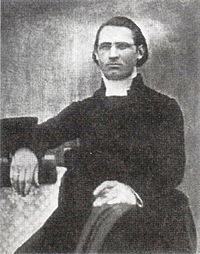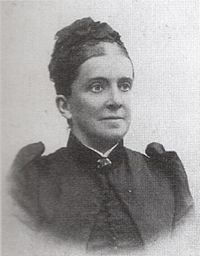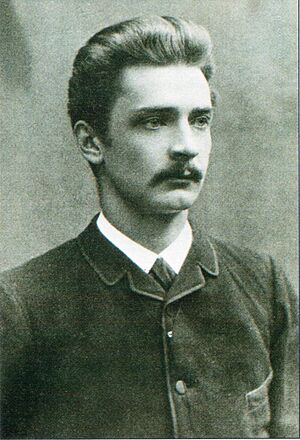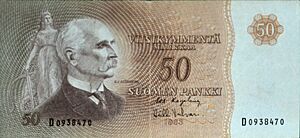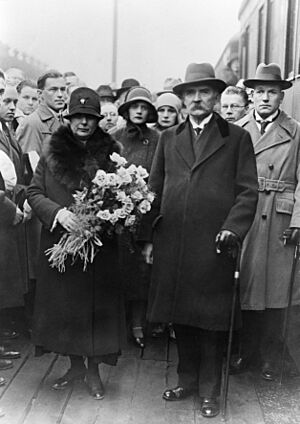Kaarlo Juho Ståhlberg facts for kids
Quick facts for kids
Kaarlo Juho Ståhlberg
|
|
|---|---|
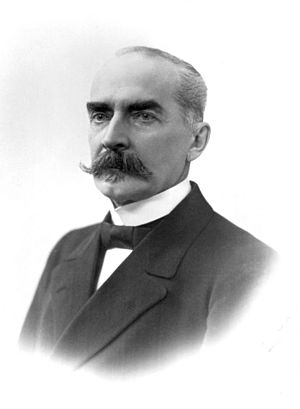
Ståhlberg in 1919
|
|
| 1st President of Finland | |
| In office 26 July 1919 – 2 March 1925 |
|
| Prime Minister | Kaarlo Castrén Juho Vennola Rafael Erich Aimo Kaarlo Cajander Kyösti Kallio Lauri Ingman |
| Succeeded by | Lauri Kristian Relander |
| Personal details | |
| Born |
Carl Johan Ståhlberg
28 January 1865 Suomussalmi, Grand Duchy of Finland, Russian Empire |
| Died | 22 September 1952 (aged 87) Helsinki, Finland |
| Political party | National Progressive Party (ED) |
| Spouses | Hedvig Irene Wåhlberg (desc.); Ester Hällström |
| Profession | Lawyer; Civil servant; Professor; Judge |
Kaarlo Juho Ståhlberg (born January 28, 1865 – died September 22, 1952) was a Finnish lawyer and professor. He was one of the most important people who helped create a republic in Finland. Ståhlberg became the first President of Finland and served from 1919 to 1925. He was a liberal nationalist, meaning he believed in freedom and national pride for his country.
Ståhlberg was very important during Finland's journey to independence. He helped write the country's constitution. As a lawyer, he made sure Finland became a democracy. He worked to protect the rule of law and started many important changes. He guided Finland to act as an independent country in the world. He used international law and diplomacy in foreign policy.
Even after his presidency, Ståhlberg continued to be a very important advisor. People often asked him for his wise opinions. Later presidents, like Juho Kusti Paasikivi, valued his advice greatly. Paasikivi once said that Ståhlberg "never made mistakes."
Contents
Kaarlo Juho Ståhlberg's Life Story
Early Years and Education
Ståhlberg was born in Suomussalmi, Finland, on January 28, 1865. At that time, Finland was part of the Russian Empire and was called the Grand Duchy of Finland. He was the second child of Johan Gabriel Ståhlberg, a pastor, and Amanda Gustafa Castrén. Many men in his family on both sides were Lutheran clergymen.
He was christened Carl Johan. Later, he changed his first names to Kaarlo Juho. Many Finns did this to make their names sound more Finnish. This was part of the Fennoman movement, which supported the Finnish language and culture.
Kaarlo and his family lived in Lahti, where he went to grammar school. His father died when Kaarlo was young. This left his family in a difficult financial situation. The family moved to Oulu, and the children went to school there. Kaarlo's mother, Amanda, worked hard to support the family.
Kaarlo's family always spoke and supported the Finnish language. Young Kaarlo went to Oulu's private Finnish high school. He was an excellent student and was at the top of his class. In 1889, he earned a Bachelor of Arts degree in Law from the University of Helsinki. He then earned his Doctorate in Law in 1893.
Career as a Professor and Public Servant
Ståhlberg began a long career helping to plan laws for the Finnish government. This was during the time when Finland was a Russian Grand Duchy. He was a "constitutionalist." This means he supported Finland's existing laws and worked against Russia's attempts to make Finland more Russian. He also supported the idea of women's suffrage, which meant women getting the right to vote.
In 1891, Ståhlberg worked for the Finnish Parliament's finance committee. In 1894, he became an assistant professor of Administrative Law and Economics at the University of Helsinki. Around this time, he became active in politics and joined the Young Finnish Party.
In 1893, Ståhlberg married his first wife, Hedvig Irene Wåhlberg. They had six children together.
In 1898, Ståhlberg was appointed as Protocol Secretary for the government's civil affairs section. This was a very high position in the Finnish government. The new Russian Governor General of Finland, Nikolai Bobrikov, approved this appointment. Bobrikov's time in office started the period of Russification. Ståhlberg was against these policies.
Ståhlberg was elected to the Helsinki City Council in 1901 and served until 1903. In 1902, he was removed from his government position. This was because he strongly believed in legal rules and opposed a law about required military service.
Career as a Politician
Ståhlberg was a member of the Finnish Parliament from 1904 to 1905. In 1905, he became a Senator in the new government led by Leo Mechelin. He was in charge of trade and industry. One of the most important jobs for this new government was to change the Finnish Parliament. Ståhlberg helped write the laws that created the modern Parliament of Finland. He resigned from the Senate in 1907. This was because Parliament rejected a law about banning alcohol.
The next year, he went back to being a professor. He became a Professor of Administrative Law at the University of Helsinki. He held this job until 1918. During this time, he wrote his most important work, "Finnish administrative law, volumes I & II." He also stayed active in politics. He was elected to the main committee of the Young Finnish Party.
Ståhlberg was a member of Parliament again from 1908 to 1910. He also served from 1913 until 1918. In 1914, Ståhlberg was the Speaker of the Parliament.
After the February Revolution in Russia in 1917, Ståhlberg was a candidate to become Vice-Chairman of the Senate. However, he did not get the support of the Social Democrats. Instead, Oskari Tokoi was elected. Ståhlberg was then appointed chairman of the Constitutional Council. This group was set up to plan a new government for Finland. This was important because the Russian Emperor Nicholas II had given up his power.
The new plan for government was based on an old Swedish law from 1772. The Russian Provisional Government rejected this plan. It was then mostly forgotten for a while. This was due to the October Revolution in Russia and Finland's declaration of independence.
Creating the Finnish Constitution
After Finland became independent in December 1917, the Constitutional Committee made new plans for an independent Republic of Finland. As chairman of the council, Ståhlberg helped write these new plans in 1918. During this time, Finland had a Finnish Civil War. There were also debates between people who wanted a republic and those who wanted a king.
Ståhlberg's ideas eventually became the Constitution of Finland in 1919. In 1918, Ståhlberg supported having a republic instead of a constitutional monarchy. More conservative people who won the civil war supported a monarchy. Ståhlberg became the first President of the Supreme Administrative Court in 1918. This meant he left Parliament. So, he was not involved when Parliament elected Prince Frederick Charles of Hesse as King of Finland in October 1918.
When it became clear Finland would be a republic, Ståhlberg also wanted the President to be elected directly by the people. However, the government chose an electoral college system. Still, the first President would be elected by Parliament.
First President of Finland
Ståhlberg became a candidate for president. He had the support of the National Progressive Party and the Agrarian League. In the 1919 Finnish presidential election, Parliament elected him President on July 25, 1919. He won against Carl Gustaf Emil Mannerheim. Ståhlberg received 143 votes, and Mannerheim received 50.
Ståhlberg became the first President of the Republic the next day. He reluctantly moved from his home in Helsinki to the Presidential Palace.
Ståhlberg's first wife had died in 1917. In 1920, as president, he married his second wife, Ester Hällström. He was a very formal person and was shy. He wrote down everything he had to say in public beforehand. He also did not like official events or traveling. Because of this, he did not visit other countries during his presidency. He only received one guest, Estonian President Konstantin Päts, in May 1922. This was the first official visit to independent Finland. The first official visit of a Finnish President abroad was made by his successor, Lauri Kristian Relander.
As the first President, Ståhlberg had to set many examples for how the President's job should be done. His time in office also saw many governments that did not last long. During his presidency, Ståhlberg appointed eight different governments. These were mostly coalitions of different parties. Ståhlberg generally supported the governments he appointed.
He made Kyösti Kallio's first government resign in January 1924. This was because he wanted early elections to get all 200 members back in Parliament. Parliament had been missing 27 members since August 1923. Those members were Communist deputies who had been arrested.
Ståhlberg supported fair social and economic changes. He wanted to make sure that even those who fought against the government in the Civil War would accept the democratic republic. He pardoned most of the prisoners from the Civil War. Many right-wing Finns and army officers criticized this decision. He signed laws that gave trade unions equal power with employers to negotiate work contracts. He also signed a law to improve public care for the poor. The Lex Kallio law distributed land from wealthy landowners to farmers who did not own land.
In foreign policy, Ståhlberg was careful with Sweden because of the Åland crisis. He was also cautious with Germany. He tried to build closer ties with Poland, the United Kingdom, and France, but he was not very successful.
Life After Presidency
Ståhlberg did not seek re-election in 1925. He found his term in office very difficult. He also believed that if he stepped down, the right-wing and those who wanted a king would accept the republic more easily. He thought that the current president had too much of an advantage when running for re-election. He was offered a job at the University of Helsinki but turned it down. Instead, he became a member of the government's Law Drafting Committee. He also served as a member of Parliament again from 1930 to 1933.
In 1930, people from the right-wing Lapua Movement kidnapped him and his wife. They tried to send them to the Soviet Union. However, this event only made the Lapua Movement lose support quickly.
Ståhlberg was a candidate in the 1931 Presidential election. He lost to Pehr Evind Svinhufvud by only two votes. He was also a candidate in the 1937 election, finishing third.
In 1946, Ståhlberg retired. He became a legal advisor to President Juho Kusti Paasikivi. Their last discussion happened less than two weeks before Ståhlberg died. He passed away in 1952. He was buried in Helsinki's Hietaniemi cemetery with full honors.
Among Finnish Presidents, Ståhlberg has a very good reputation. People generally see him as a moral and principled person. He is known as a defender of democracy and the rule of law. He is also called the father of the Finnish Constitution. His choice to willingly step down from the presidency is admired. It shows that he was not a politician who only wanted power.
Honours
Awards and Decorations
 Finland : Grand Cross of the Order of the White Rose (Finland)
Finland : Grand Cross of the Order of the White Rose (Finland) Estonia : Cross of Liberty (Estonia)
Estonia : Cross of Liberty (Estonia) Latvia : Order of the Three Stars
Latvia : Order of the Three Stars
Images for kids
See also
 In Spanish: Kaarlo Juho Ståhlberg para niños
In Spanish: Kaarlo Juho Ståhlberg para niños


